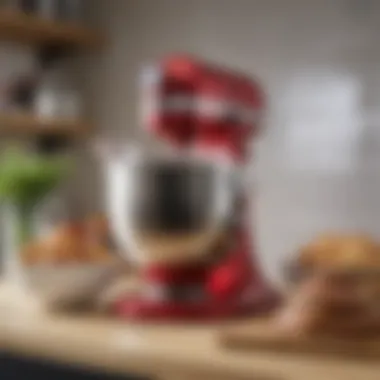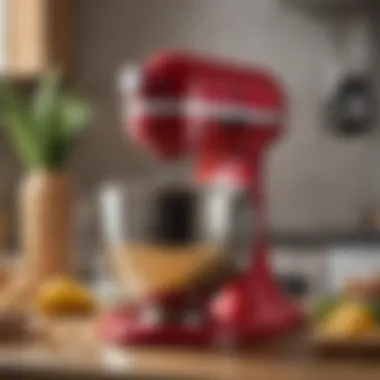Exploring KitchenAid Mixer Sizes: A Comprehensive Guide


Intro
KitchenAid mixers have long been a staple in kitchens around the world. These versatile appliances are renowned for their ability to simplify many cooking tasks. When choosing a KitchenAid mixer, understanding the various sizes available is crucial. Each size offers distinct features and capabilities that cater to diverse culinary needs. This in-depth exploration aims to guide readers in selecting the most appropriate mixer, ensuring every culinary endeavor is executed with efficiency and precision.
This overview will outline the key points discussed throughout the article: the characteristics of different sizes, their suitable applications, and how to optimize your kitchen experience based on your specific requirements.
A range of sizes and options means that family cooks and professional chefs alike can find a mixer that suits their specific needs. Whether you're a casual baker or a serious culinary artist, there's a KitchenAid mixer ideal for your operations. Let's delve deeper into the world of KitchenAid mixers.
Prologue to KitchenAid Mixers
KitchenAid mixers have become a staple in both professional and home kitchens. They offer a unique combination of functionality, durability, and style. Knowing about these mixers is essential for anyone looking to enhance their culinary experience. The focus on different sizes will help readers identify the right mixer that fits their individual cooking needs and spaces. Each size comes with its advantages, catering to various requirements and preferences.
History of KitchenAid Mixers
The history of KitchenAid mixers is a tale of innovation and quality. It started in the early 1900s when Herbert Johnston, a member of the Hobart Manufacturing Company, created the first stand mixer in 1919. Initially, it was targeted towards commercial baking but soon caught the attention of home cooks. The first model, known as the "Model H," gained popularity for its performance and reliability. In 1937, the company rebranded and introduced the KitchenAid name, which became synonymous with high-quality kitchen appliances.
Over the decades, KitchenAid has evolved, launching various models and attachments that accommodate diverse culinary tasks. From bread-making to candy tempering, KitchenAid mixers have demonstrated versatility. The iconic design has remained a favorite, appealing not only to functionality but also to kitchen aesthetics.
The Popularity of KitchenAid Mixers
KitchenAid mixers hold a special place among culinary enthusiasts. Their enduring popularity can be attributed to several key factors:
- Brand Recognition: KitchenAid is a well-established brand, recognized for its quality and performance.
- Versatility: These mixers are compatible with numerous attachments, allowing users to perform a vast range of cooking tasks, from slicing to grinding.
- Durability: Made with sturdy materials, KitchenAid mixers are designed to last, making them a wise investment.
- Design and Customization: They come in various colors and styles, allowing users to choose a mixer that matches their kitchen decor.
This blend of innovation, reliability, and aesthetic appeal ensures that KitchenAid mixers remain in high demand, influencing not just home cooks but also professional chefs.
Overview of Mixer Sizes
Understanding the different sizes of KitchenAid mixers is crucial for anyone who enjoys cooking and baking. The significance of this section lies in its potential to guide users toward making informed decisions based on their individual needs and kitchen space. KitchenAid mixers vary in capacity and performance, which means the right choice can greatly enhance efficiency and overall cooking experience.
A key element in selecting a mixer size is to match it with your intended use. This means considering not only how often and what type of cooking you do, but also how many servings you typically prepare. Some mixers are designed for casual use, while others can handle the demands of frequent, intensive cooking tasks. The advantages of choosing the appropriate size can lead to better results.
In summary, the overview of mixer sizes provides a foundation for understanding the diverse options available, which can ultimately improve culinary outcomes.
Understanding Mixer Capacity
Mixer capacity directly relates to the amount of dough or batter a mixer can handle at one time. KitchenAid mixers usually come in various capacities, commonly measured in quarts. For instance, a 3-quart mixer is suitable for smaller batches of dough or batter, while a 6-quart mixer can manage larger quantities effectively.
When evaluating your requirements, consider how much food you prepare on average. If you often make batches of bread, pie, or cookie dough, a larger capacity mixer is advisable. Conversely, if your culinary endeavors are limited to small desserts or single servings, a smaller capacity might suffice.
This understanding of mixer capacity is essential for buying the right equipment tailored to your needs.
Common Size Options Available
When exploring KitchenAid mixers, one can typically find three common sizes: small, medium, and large. Each size serves a specific purpose and offers unique features.
- Small Mixers (3-4 quarts): Ideal for occasional bakers or singles. These mixers are lightweight and easy to store, making them great for small kitchens.
- Medium Mixers (5-6 quarts): This size is versatile and can handle a variety of tasks. It works well for families and is suitable for most baking and cooking tasks.
- Large Mixers (7-8 quarts): Best for those who enjoy entertaining or regularly cook for large groups. It can handle heavy doughs without straining.
By recognizing these common size options, potential buyers can select a mixer that aligns with their cooking habits and living situation.
Small KitchenAid Mixers
Small KitchenAid mixers represent a crucial aspect of culinary equipment for home cooks, especially for those with limited kitchen space or who engage primarily in smaller meal preparations. These mixers offer a versatile solution that combines efficiency with compact design. Their significance in this article lies in understanding how they can still deliver powerful performance despite their size.


Features of Small Mixers
Powerful Motor: Small KitchenAid mixers are equipped with reliable motors that provide sufficient power for various tasks, such as mixing, kneading, and whipping. This capability allows users to handle a range of recipes, from simple batter to more complex doughs.
Compact Design: One of the standout features of small mixers is their size. Their compactness makes them easy to store in cabinets or small countertops. This is particularly beneficial for urban dwellers or those with limited kitchen space.
Variety of Attachments: Small mixers often come with a variety of attachments that enhance their utility. Users can switch between mixing bowls, dough hooks, and beaters depending on the task at hand. This adaptability allows for various cooking and baking techniques, making small mixers a valuable tool in any kitchen.
Affordable Price Range: Generally, small KitchenAid mixers are more cost-effective compared to their larger counterparts. This price point makes them accessible to a wider range of users, particularly entry-level home cooks or those on a budget.
Ideal Uses for Small Mixers
Small KitchenAid mixers are ideal for various cooking needs, making them a sound investment for casual bakers and seasoned chefs alike. Here are some preferred uses:
- Baking for Small Groups: Perfect for preparing quick treats like cookies or cupcakes when baking for a small family gathering or get-together.
- Whipping Cream and Egg Whites: Their efficiency in whipping up light mixtures makes them suitable for desserts that require delicate textures.
- Making Sauces and Dressings: Small mixers are handy for blending sauces, dressings, and dips, enhancing flavor without requiring extensive cleanup.
- Faster Small Batch Cooking: Faster processing of smaller batches allows cooks to experiment with new recipes without commitment, fostering culinary creativity.
"For those who love to cook but face space challenges, a small KitchenAid mixer can transform your culinary experience."
In summary, small KitchenAid mixers encompass essential features and uses that cater to a broad audience. Their compact design and powerful performance enable users to optimize their kitchen activities efficiently. Understanding these mixers provides valuable insight for anyone considering investing in kitchen equipment that fits their specific needs.
Medium KitchenAid Mixers
Medium KitchenAid mixers occupy a unique space in the spectrum of kitchen appliances. They balance between the compact utility of small mixers and the robust capacity of large mixers. This segment is widely popular among both home cooks and professional chefs due to its versatility and functionality.
When exploring kitchen gadgets, the medium mixer is essential. Its size typically allows for a capacity range of about 4.5 to 5.5 quarts, making it ideal for many baking and cooking tasks. Understanding the specifics of medium KitchenAid mixers can directly influence culinary productivity. They can handle a variety of recipes with ease, from bread dough to whipped cream, thus offering a comprehensive solution for diverse culinary needs.
Features of Medium Mixers
Medium KitchenAid mixers come equipped with several key features that distinguish them from their smaller and larger counterparts. Here are some notable characteristics:
- Powerful Motor: Most medium models have a motor ranging from 300 to 500 watts, which provides sufficient power for mixing heavy ingredients like bread dough.
- Tilt-Head or Bowl-Lift Design: Many medium mixers feature a tilt-head mechanism, allowing for easy access to the bowl without removing the mixer head.
- Versatile Attachments: These mixers often support various attachments like pasta makers, food grinders, and spiralizers, enhancing their functionality.
- Durable Construction: Made from robust materials, medium mixers are designed for longevity, capable of withstanding heavy use in the kitchen.
These features contribute to the overall efficiency of the mixer, helping users achieve consistency in their culinary tasks.
Best Applications for Medium Mixers
Medium KitchenAid mixers shine in several applications, making them a preferred choice for many. Here are some of the best uses:
- Baking Breads and Pastries: Thanks to their power and capacity, medium mixers excel at kneading dough for bread and pastries.
- Whipping Cream and Egg Whites: Their mixing bowls are deep enough to manage larger batches of creams and egg whites.
- Making Sauces and Batters: The versatility allows users to combine ingredients smoothly for sauces or cake batters, ensuring even textures.
- Mixing Heavy Ingredients: The strong motor enables the handling of heavy mixtures without any strain on the mixer.
By considering these applications, users can maximize the use of their medium KitchenAid mixers, ultimately enhancing their cooking and baking experiences.
Ultimately, medium KitchenAid mixers offer an excellent balance of size and capacity, making them suitable for a wide range of culinary tasks.
Large KitchenAid Mixers
Large KitchenAid mixers serve a pivotal role in the spectrum of kitchen appliances. As culinary demands expand, both in complexity and volume, these robust mixers offer the performance needed to tackle substantial tasks. They shine in settings where quantity is critical, making them indispensable for both professional chefs and avid home bakers. With bigger capacity comes the ability to mix larger batches, which translates into time saved and increased efficiency. Therefore, understanding the specifics of large mixers is essential for selecting the right tool for your culinary endeavors.
Features of Large Mixers
Large KitchenAid mixers are equipped with several features that distinguish them from their smaller counterparts.
- Increased Bowl Capacity: Typically ranging from 6 to 7 quarts, these mixers handle larger volumes of ingredients efficiently.
- Powerful Motors: They often have more powerful motors, which contribute to better performance when mixing dense or large quantities of dough.
- Sturdy Construction: Designed for heavy use, these mixers usually feature a more robust build, designed to withstand the demands of larger mixing tasks.
- Planetary Mixing Action: This technology ensures that ingredients are mixed thoroughly, as the beater rotates while also moving around the bowl, providing even mixing results.
- Attachments Compatibility: Large mixers are compatible with a broader range of attachments, allowing for versatility in food preparation tasks.
Due to these features, large KitchenAid mixers are favored by those who require a reliable appliance that handles demanding culinary tasks seamlessly.


Recommended Uses for Large Mixers
Large KitchenAid mixers are ideal for various culinary applications, particularly in situations where volume and potency are key.
- Batch Baking: When preparing cookies, cakes, or bread, these mixers excel in creating large amounts of batter at once, saving time during the baking process.
- Whipping Cream or Egg Whites: With their powerful motors, large mixers quickly whip large quantities, crucial for making desserts like mousse or pavlova.
- Doughs for Pizza or Bread: Kneading dough can be labor-intensive. A large mixer simplifies this, providing consistent mixing and kneading for pizza and bread.
- Preparing Large Meals: For gatherings and events where many people are served, the ability to combine substantial ingredients makes large mixers indispensable.
- Cooking Classes or Demonstrations: Chefs can utilize large mixers to showcase techniques while preparing for a big audience.
In summary, large KitchenAid mixers are not only efficient but they also open up a world of culinary possibilities, making them a worthy investment for passionate cooks.
Large KitchenAid mixers embody strength and reliability, catering to both home kitchens and professional settings, significantly enhancing productivity in meal preparation.
Their features and versatility ensure that they meet a diverse range of cooking needs.
Comparison of KitchenAid Mixer Sizes
In this section, we examine the differences among the various sizes of KitchenAid mixers. This comparison is essential to help users choose the mixer that aligns best with their culinary requirements and kitchen environment. With various sizes available, understanding the unique attributes of each can lead to better decision making. Factors such as ease of use, capacity for preparation, and specific kitchen space constraints are vital elements to consider.
A comprehensive evaluation of these mixers allows the user to grasp how each size can impact their cooking styles, efficiency, and overall satisfaction in the kitchen. Choosing the right size can enhance the cooking experience, avoid frustration, and tailor the mixer’s abilities to the intended tasks. Below, we analyze the pros and cons of each size to identify the most suitable option for different needs.
Pros and Cons of Each Size
When evaluating KitchenAid mixers, each size comes with benefits and drawbacks. This examination helps clarify what to expect from each option and ensures informed choices.
- Small KitchenAid Mixers
- Medium KitchenAid Mixers
- Large KitchenAid Mixers
- Pros:
- Cons:
- Compact design suitable for limited counter space.
- Easier to store when not in use.
- Generally lightweight, making them easier to handle.
- Limited capacity for larger batches.
- May struggle with heavy doughs or thick mixtures.
- Pros:
- Cons:
- A balance between size and capacity, versatile for many tasks.
- Sufficient power for kneading dough and mixing batter effectively.
- Suitable for everyday cooking and baking.
- Might take more counter space compared to small models.
- Some users may find it heavy to lift when needed.
- Pros:
- Cons:
- Offers significant capacity for bulk preparation and large batches.
- Excellent power, making it ideal for heavy mixing tasks.
- Often include advanced features and options for attachments.
- Requires ample storage and counter space.
- May be costly compared to smaller models, depending on features.
Understanding these pros and cons can help you find a model that meets your specific cooking needs without compromising on functionality.
Suitability for Different Cooking Styles
The choice of a KitchenAid mixer size can significantly affect the efficiency and enjoyment of cooking. Different cooking styles necessitate different mixer capabilities.
- Casual Home Cooks:
- Baking Enthusiasts:
- Professional or Serious Chefs:
- Small mixers might suffice for occasional baking tasks, like brownies or quick bread.
- Medium mixers are a solid choice for those who bake regularly, offering the power and capacity needed for cakes and cookies.
- A large mixer becomes essential when preparing large volumes of dough or intricate recipes, where the mixer can consistently deliver top performance.


"The right mixer can elevate your cooking, making tasks easier and more enjoyable."
Ultimately, the mixer size you select should align with your cooking frequency, types of recipes, and available space. Each option can address specific cooking demands, so choose wisely.
Factors to Consider When Choosing a Mixer Size
Choosing the right size of a KitchenAid mixer is crucial. It affects the effectiveness and efficiency of your cooking experience. When selecting a mixer, several factors come into play. Understanding these elements can help in making an informed decision. Ultimately, the aim is to ensure that the mixer you choose meets your culinary needs without hindering your kitchen experience.
Kitchen Space Constraints
Kitchen space is often a limiting factor when selecting a mixer. If you have a small kitchen, a larger model may not fit comfortably. It is essential to measure your available counter space before shopping. Consider both the width and height of the mixer. A compact mixer may have a smaller footprint, allowing easier storage in tight spaces. On the other hand, if you have ample space, a larger mixer could be more suitable for your needs.
Meal Preparation Needs
Understanding your meal preparation needs will guide your mixer size choice. For occasional bakers, a smaller model may suffice. However, if you often prepare large batches or complex recipes, a larger mixer allows for higher capacity. Assess the types of meals you cook and how much you generally prepare. For instance, bread dough typically requires more power and volume. Analyze your cooking habits to select a mixer that can handle your workload effectively.
Budget Considerations
Budget is a significant determinant when selecting a KitchenAid mixer size. Smaller models typically cost less. Investing in a larger mixer can be more expensive, but it offers expanded capabilities. Evaluate your budget first and design a list of requirements for features you need. Remember that the initial cost is one aspect but consider the long-term value as well. A more expensive mixer with higher capacity might save money in the long run through versatility and durability.
"A well-planned purchase means your kitchen tool enhances your cooking, rather than becoming an obstacle."
These considerations collectively help narrow down options. Each factor plays a distinct role in guiding you toward the best mixer for your kitchen. By keeping these points in mind, ensuring you have the right equipment for your culinary tasks becomes much simpler.
Maintenance of KitchenAid Mixers
Maintaining a KitchenAid mixer is crucial for its performance and longevity. Proper upkeep ensures the mixer operates efficiently and lasts for many years. Regular maintenance helps avoid costly repairs and replacements. Additionally, a well-maintained mixer can enhance the overall cooking experience. This section covers the importance of maintenance and provides practical advice for keeping your mixer in optimal condition.
Regular Cleaning Practices
To maintain the functionality of your KitchenAid mixer, cleaning is essential. Here are some recommended practices:
- Daily Wipe Down: After each use, wipe down the exterior with a damp cloth. Avoid using abrasive cleaners which can scratch the surface.
- Detachable Parts: Remove and wash all detachable parts, like the bowl and mixing attachments, in warm soapy water. For most attachments, the dishwasher is also an option.
- Motor Area Care: Be careful around the motor area. Use a dry cloth to remove any flour or ingredient residue that may have settled there. This ensures ventilation and prevents overheating.
- Avoid Water Contact: Never submerge the base of the mixer in water. Ensure no water gets into the motor casing, as this can cause damage.
Preventative Care for Longevity
Engaging in preventative care is key for the longevity of your KitchenAid mixer. By addressing potential issues before they escalate, you can ensure better functioning over time. Consider these preventative measures:
- Lubricate Moving Parts: Occasionally, lubricating the gears can keep your mixer running smoothly. Refer to the user manual for specific lubrication guidelines.
- Check for Wear: Regularly inspect the power cord and attachments. Any fraying or damage requires immediate attention to prevent hazards and misuse.
- Proper Storage: When not in use, store the mixer in a cool, dry place. Keep it covered to avoid dust accumulation, which can affect performance over time.
- Professional Servicing: Consider having the mixer serviced by a professional at least once a year, especially if you use it frequently. They can assess for issues that may not be obvious to the average user.
Keeping your KitchenAid mixer clean and maintained is not just about aesthetics; it directly affects its performance and durability.
By following these maintenance and care tips, you can ensure your KitchenAid mixer remains a reliable partner in your culinary creations for years to come.
The End
In this article, we explored KitchenAid mixers in various sizes, a crucial aspect for achieving culinary efficiency and excellence. The size of a mixer has significant implications on its functionality, usability, and versatility in the kitchen. When selecting a KitchenAid mixer, factors such as kitchen space, meal preparation needs, and budget constraints play critical roles. Understanding these elements allows for an informed decision that reflects one’s cooking style and frequency of use.
Final Thoughts on Mixer Selection
Choosing the right KitchenAid mixer size is not merely a matter of preference but is often dictated by one’s culinary needs. A small KitchenAid mixer can serve well for those who bake occasionally or who have limited kitchen space. In contrast, larger mixers are better for avid bakers or those managing larger volume tasks. Evaluating the features of different sizes is imperative.
- Small Mixers: Compact and agile, ideal for smaller batches.
- Medium Mixers: A balanced choice that covers a range of cooking tasks.
- Large Mixers: Best for serious cooks who need high capacity for dough or extensive mixing.
Ultimately, one must consider how often and what kinds of meals are prepared. Those who frequently entertain or bake in bulk might prioritize larger sizes.
Encouragement to Explore Cooking with KitchenAid
Exploring the capabilities of a KitchenAid mixer can significantly enhance your cooking experience. Each size offers unique advantages, which can inspire creativity in the kitchen. Investing time to understand the potential of these mixers, regardless of their size, can elevate the quality of culinary endeavors. You can experiment with various recipes and techniques, whether whipping light meringues or kneading thick bread dough.
Ultimately, your KitchenAid mixer can be more than just a tool; it can reinvent the way you approach cooking. By embracing this versatile equipment, you're inviting creativity and efficiency into your kitchen. Whether you are a novice cook or a seasoned chef, this appliance can facilitate an enhanced cooking experience.







